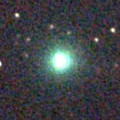
|
It brightened very rapidly. Now it is very bright as 9.0 mag (Sept. 7, Chris Wyatt). It will brighten up to 8.5 mag from September to October. But the condition is bad in this apparition. In the Southern Hemisphere, it stays observable after this while the comet will be fading. But it stays locating low. It is not observable after this in the Northern Hemisphere.
Date(TT) R.A. (2000) Decl. Delta r Elong. m1 Best Time(A, h)
Sept. 4 9 5.34 -0 13.0 1.816 1.032 27 8.8 4:07 (269, -1)
Sept.11 9 28.17 -5 56.7 1.808 1.049 29 8.6 4:13 (276, -2)
|
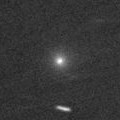
|
It was observed at 9-10 mag from late July to early August. Now it is not observable. It will appear in the morning sky in December, but it will be fainter than 15 mag at that time.
Date(TT) R.A. (2000) Decl. Delta r Elong. m1 Best Time(A, h)
Sept. 4 11 3.47 18 48.0 1.848 0.885 11 9.8 19:49 (119, -8)
Sept.11 11 34.69 14 44.9 1.921 0.952 11 10.2 19:38 (114, -8)
|
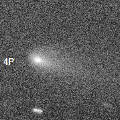
|
Now it is 11.3 mag (Aug. 18, Osamu Miyazaki). It stays observable at 10-11 mag in excellent condition from summer to autumn.
Date(TT) R.A. (2000) Decl. Delta r Elong. m1 Best Time(A, h)
Sept. 4 4 57.98 18 42.2 1.338 1.620 86 10.5 4:07 (294, 59)
Sept.11 5 16.03 18 17.5 1.292 1.619 88 10.4 4:13 (300, 62)
|
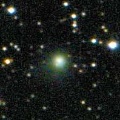
|
Now it is 11.6 mag (Aug. 18, Osamu Miyazaki). It will brighten up to 10 mag in winter. In the Northern Hemisphere, it stays observable in good condition for a long time. In the Southern Hemisphere, it is not observable until November.
Date(TT) R.A. (2000) Decl. Delta r Elong. m1 Best Time(A, h)
Sept. 4 7 0.68 45 17.2 4.098 3.739 62 11.2 4:07 (238, 44)
Sept.11 7 9.38 44 44.4 3.997 3.720 66 11.1 4:13 (240, 48)
|
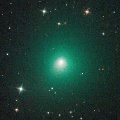
|
Now it is very bright as 10.7 mag (Aug. 31, Chris Wyatt). It will be fading after this. In the Northern Hemisphere, it will be getting lower gradually in the evening. In the Southern Hemisphere, it stays observable in good condition for a while.
Date(TT) R.A. (2000) Decl. Delta r Elong. m1 Best Time(A, h)
Sept. 4 15 23.39 -16 29.6 2.256 2.156 71 11.1 19:49 ( 51, 20)
Sept.11 15 36.68 -18 40.1 2.347 2.182 68 11.3 19:38 ( 50, 18)
|
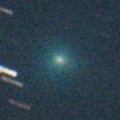
|
It brightened very rapidly. Now it is very bright as 11.1 mag (Aug. 6, Carlos Labordena). It will be fading after this. It stays observable in the morning sky for a long time.
Date(TT) R.A. (2000) Decl. Delta r Elong. m1 Best Time(A, h)
Sept. 4 7 1.22 26 58.1 1.437 1.241 57 11.2 4:07 (261, 38)
Sept.11 7 21.14 26 56.4 1.461 1.299 60 11.7 4:13 (263, 41)
|
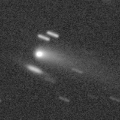
|
Now it is 12.7 mag (Aug. 25, Ken-ichi Kadota). It will brighten up to 9 mag, and will be observable in good condition in winter.
Date(TT) R.A. (2000) Decl. Delta r Elong. m1 Best Time(A, h)
Sept. 4 3 12.94 13 59.2 0.684 1.413 111 11.9 4:07 (351, 69)
Sept.11 3 37.57 15 57.9 0.625 1.372 112 11.5 4:13 (357, 71)
|
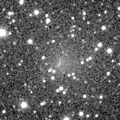
|
Now it is bright as 12.5 mag (Aug. 31, Chris Wyatt). It will brighten very rapidly, and it will be observable at 10 mag in good condition from October to December. In the Northern Hemisphere, it locates somewhat low at the high light.
Date(TT) R.A. (2000) Decl. Delta r Elong. m1 Best Time(A, h)
Sept. 4 17 17.26 -15 40.2 0.786 1.364 98 12.0 19:49 ( 25, 35)
Sept.11 17 36.64 -19 13.7 0.807 1.357 96 11.6 19:38 ( 23, 32)
|
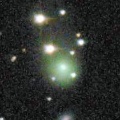
|
Now it is 12.2 mag (Aug. 29, Toshihiko Ikemura, Hirohisa Sato). It is expected to be observable at 5-6 mag for a long time from 2022 to 2023. In the Northern Hemisphere, it is not observable at the high light from 2022 autumn to 2023 summer. In the Southern Hemisphere, it stays low for a while. But it will be observable in good condition at the high light.
Date(TT) R.A. (2000) Decl. Delta r Elong. m1 Best Time(A, h)
Sept. 4 16 56.95 32 0.5 5.388 5.435 87 12.0 19:49 ( 90, 67)
Sept.11 16 56.70 30 32.8 5.398 5.376 83 12.0 19:38 ( 89, 64)
|
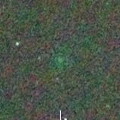
|
It brightened up to 4 mag in major outburst in 2016. In this apparition, it brightened up to 10.5 mag in early August (Aug. 8, Rob Kaufman). Now it is fading rapidly. It has already faded down to 14.0 mag (Aug. 31, Chris Wyatt). In the Southern Hemisphere, it stays locating low in the evening sky until October. In the Northern Hemisphere, it stays locating extremely low.
Date(TT) R.A. (2000) Decl. Delta r Elong. m1 Best Time(A, h)
Sept. 4 13 28.10 -4 0.7 1.829 1.251 40 13.1 19:49 ( 80, 7)
Sept.11 13 54.59 -5 59.9 1.890 1.307 40 13.7 19:38 ( 77, 8)
|
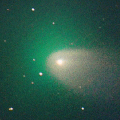
|
It brightened up to 9.7 mag in June (June 4, Michael Jager). Now it is fading. It has already faded down to 12.4 mag (Aug. 31, Chris Wyatt). In the Southern Hemisphere, it stays observable in excellent condition for a long time. In the Northern Hemisphere, it becomes extremely low after this.
Date(TT) R.A. (2000) Decl. Delta r Elong. m1 Best Time(A, h)
Sept. 4 23 42.23 -51 54.3 0.838 1.702 134 13.2 0:51 ( 0, 3)
Sept.11 23 34.09 -51 18.6 0.904 1.754 133 13.5 0:16 ( 0, 4)
|
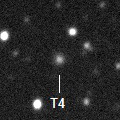
|
Now it is 14.6 mag (July 12, Chris Wyatt). It is expected to brighten up to 11.5 mag in 2022. In the Southern Hemisphere, it stas observable in good condition for a long time, although it becomes extremely low temporarily from August to September. In the Northern Hemisphere, it is not observable until November.
Date(TT) R.A. (2000) Decl. Delta r Elong. m1 Best Time(A, h)
Sept. 4 10 12.32 -22 48.3 5.652 4.822 31 13.6 4:07 (280,-27)
Sept.11 10 20.22 -23 4.5 5.631 4.795 30 13.5 4:13 (283,-22)
|

|
Now it is 13.6 mag (Aug. 28, Chris Wyatt). It will be unobservable soon. However, it will be observable again at 14 mag in November in the Northern Hemisphere, or in January in the Southern Hemisphere.
Date(TT) R.A. (2000) Decl. Delta r Elong. m1 Best Time(A, h)
Sept. 4 13 44.66 -4 21.3 4.240 3.595 44 13.5 19:49 ( 77, 10)
Sept.11 13 46.79 -3 57.0 4.352 3.619 38 13.6 19:38 ( 80, 7)
|
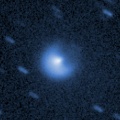
|
Outburst occured on Aug. 25. Now it is 15.6 mag (Sept. 3, Jean-Francois Soulier).
Date(TT) R.A. (2000) Decl. Delta r Elong. m1 Best Time(A, h)
Sept. 4 4 52.69 31 14.3 5.895 5.910 85 13.6 4:07 (271, 66)
Sept.11 4 54.85 31 25.5 5.787 5.912 92 13.6 4:13 (276, 72)
|
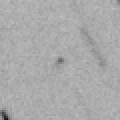
|
Now it is 15.0 mag (Aug. 28, Chris Wyatt). It will brighten rapidly up to 9 mag in winter. It will be observable in good condition. In the Southern Hemisphere, it is observable in excellent condition. In the Northren Hemisphere, it is not observable until November.
Date(TT) R.A. (2000) Decl. Delta r Elong. m1 Best Time(A, h)
Sept. 4 0 7.15 -56 27.4 1.330 2.112 128 14.2 1:16 ( 0, -1)
Sept.11 23 58.87 -57 43.7 1.297 2.060 126 13.9 0:40 ( 0, -3)
|
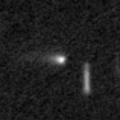
|
Now it is 14.2 mag (Sept. 3, Michael Jager). It will approach to Earth down to 0.2 a.u. in December, and it is expected to brighten up to 4 mag. In the Northern Hemisphere, it stays observable in good condition for a long time until December while the comet is brightening gradually, although it becomes extremely low temporarily in September. In the Southern Hemisphere, it is not observable until mid December.
Date(TT) R.A. (2000) Decl. Delta r Elong. m1 Best Time(A, h)
Sept. 4 10 56.48 41 0.8 3.009 2.241 33 14.4 19:49 (137, 6)
Sept.11 11 1.81 40 5.5 2.881 2.144 35 14.1 4:13 (226, 8)
|

|
Now it is 14.5 mag (Aug. 10, Chris Wyatt). It stays 13-14 mag from 2020 to 2021. It will be observable in good condition after this in the Southern Hemisphere. It locates low in the Northern Hemisphere.
Date(TT) R.A. (2000) Decl. Delta r Elong. m1 Best Time(A, h)
Sept. 4 18 45.30 -35 32.2 2.447 3.044 117 14.4 19:51 ( 0, 19)
Sept.11 18 48.04 -35 25.6 2.544 3.057 111 14.5 19:38 ( 3, 20)
|
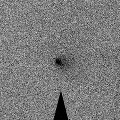
|
It brightened up to 10.1 mag in spring (Apr. 10, Marco Goiato). Now it is fading. It has already faded down to 14.7 mag (Sept. 3, Michael Jager). It stays observable in good condition for a long time after this while the comet will fading.
Date(TT) R.A. (2000) Decl. Delta r Elong. m1 Best Time(A, h)
Sept. 4 4 42.65 8 40.2 1.857 2.129 91 14.5 4:07 (312, 55)
Sept.11 4 48.11 8 24.1 1.818 2.173 96 14.6 4:13 (323, 58)
|
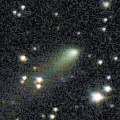
|
Now it is 14.7 mag (Sept. 2, Michael Jager). It stays 14 mag until October, and it is observable in good condition. It locates somewhat low in the Southern Hemisphere.
Date(TT) R.A. (2000) Decl. Delta r Elong. m1 Best Time(A, h)
Sept. 4 16 36.99 25 53.2 2.192 2.308 83 14.5 19:49 ( 80, 61)
Sept.11 16 27.22 24 21.1 2.312 2.302 76 14.6 19:38 ( 83, 55)
|
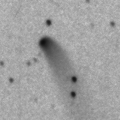
|
Now it is 14.7 mag (Aug. 28, Chris Wyatt). It stays 14-15 mag until the end of 2021. In the Southern Hemisphere, it stays observable in good condition for a long time. It locates low in the Northern Hemisphere.
Date(TT) R.A. (2000) Decl. Delta r Elong. m1 Best Time(A, h)
Sept. 4 22 59.93 -32 34.3 3.600 4.532 154 14.6 0:09 ( 0, 23)
Sept.11 22 53.40 -31 58.9 3.635 4.549 152 14.7 23:30 ( 0, 23)
|
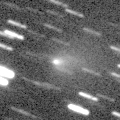
|
Outburst occured in early August. Now it is 15.2 mag (Aug. 25, Thomas Lehmann). In the Northern Hemisphere, it stays observable in good condition. In the Southern Hemipsphere, it stays locating extremely low after this.
Date(TT) R.A. (2000) Decl. Delta r Elong. m1 Best Time(A, h)
Sept. 4 5 20.50 42 22.4 2.520 2.542 79 14.7 4:07 (244, 62)
Sept.11 5 30.14 43 7.6 2.466 2.570 84 14.8 4:13 (241, 66)
|
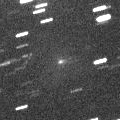
|
Bright new periodic comet. Now it is 14.7 mag (Sept. 3, Michael Jager). It stays observable in good condition for a long time. It stays 15 mag until November. Juan Jose Gonzalez reported it is very bright as 11.5 mag on Sept. 5.
Date(TT) R.A. (2000) Decl. Delta r Elong. m1 Best Time(A, h)
Sept. 4 7 11.55 21 38.3 1.500 1.234 54 14.8 4:07 (266, 34)
Sept.11 7 37.42 19 46.4 1.496 1.241 55 14.8 4:13 (269, 35)
|
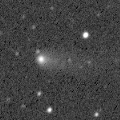
|
Now it is 14.8 mag (Aug. 31, Chris Wyatt). It was expected to brighten up to 13 mag from spring to summer. But actually, it is fainter than originally expected. It stays 14-15 mag until early autumn. In the Southern Hemisphere, it stays observable in good condition for a long time. In the Northern Hemisphere, it is not observable until July in 2022.
Date(TT) R.A. (2000) Decl. Delta r Elong. m1 Best Time(A, h)
Sept. 4 20 42.84 -85 19.1 3.323 3.656 101 14.9 21:52 ( 0,-30)
Sept.11 20 40.42 -84 8.2 3.370 3.668 99 15.0 21:22 ( 0,-29)
|

|
Now it is 15.1 mag (Aug. 31, Chris Wyatt). It stays at 14-15 mag for a long time from 2021 to 2022. It stays observable in good condition after this while brightening gradually.
Date(TT) R.A. (2000) Decl. Delta r Elong. m1 Best Time(A, h)
Sept. 4 16 21.50 -14 44.1 5.006 5.014 84 15.0 19:49 ( 40, 30)
Sept.11 16 20.70 -15 40.9 5.123 5.010 77 15.0 19:38 ( 44, 27)
|
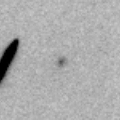
|
Now it is 15.2 mag (Aug. 27, Toshihiko Ikemura, Hirohisa Sato). It stays 15 mag until November. It will be observable in excellent condition in the Northern Hemisphere. It locates somewhat low in the Southern Hemisphere.
Date(TT) R.A. (2000) Decl. Delta r Elong. m1 Best Time(A, h)
Sept. 4 5 10.54 20 53.3 1.450 1.661 82 15.3 4:07 (287, 58)
Sept.11 5 27.79 22 2.4 1.399 1.660 85 15.2 4:13 (290, 62)
|
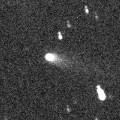
|
Now it is 14.9 mag (Aug. 30, Toshihiko Ikemura, Hirohisa Sato). It stays 15 mag until October, and it is observable in good condition.
Date(TT) R.A. (2000) Decl. Delta r Elong. m1 Best Time(A, h)
Sept. 4 23 15.91 -12 21.7 1.293 2.296 172 15.3 0:25 ( 0, 43)
Sept.11 23 12.50 -13 34.1 1.296 2.296 171 15.3 23:49 ( 0, 41)
|
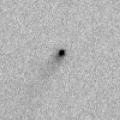
|
Now it is 15.9 mag (Aug. 27, Toshihiko Ikemura, Hirohisa Sato). It stays 15 mag until September. In the Northern Hemisphere, it stays observable in good condition for a long time. In the Southern Hemisphere, it will be getting lower gradually after this.
Date(TT) R.A. (2000) Decl. Delta r Elong. m1 Best Time(A, h)
Sept. 4 6 4.73 24 51.7 1.550 1.538 70 15.3 4:07 (271, 49)
Sept.11 6 24.99 26 19.3 1.516 1.549 72 15.4 4:13 (271, 52)
|

|
Now it is 15.8 mag (Aug. 10, Thomas Lehmann). It will brighten up to 13 mag in 2022. In 2021, it is observable at 14-15 mag in good condition.
Date(TT) R.A. (2000) Decl. Delta r Elong. m1 Best Time(A, h)
Sept. 4 13 53.34 -9 23.4 3.963 3.377 48 15.5 19:49 ( 72, 8)
Sept.11 14 1.23 -10 18.2 4.020 3.364 43 15.5 19:38 ( 73, 6)
|
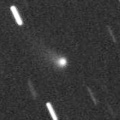
|
Now it is 15.7 mag (Aug. 11, Thomas Lehmann). In the Northern Hemisphere, it stays observable at 15-16 mag for a long time from spring to early 2022. In the Southern Hemisphere, it is not observable until the end of 2021.
Date(TT) R.A. (2000) Decl. Delta r Elong. m1 Best Time(A, h)
Sept. 4 12 38.01 37 47.5 3.726 3.008 38 15.5 19:49 (123, 19)
Sept.11 12 41.81 35 32.9 3.760 3.012 36 15.6 19:38 (122, 16)
|
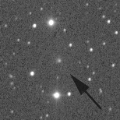
|
It brightened up to 14.2 mag in early summer (June 10, Thomas Lehmann). Now it is not observable. It will be fading after this. In the Northern Hemisphere, it will appear in the morning sky at 16 mag in October. In the Southern Hemisphere, it will never be observable again.
Date(TT) R.A. (2000) Decl. Delta r Elong. m1 Best Time(A, h)
Sept. 4 11 7.36 20 32.8 3.028 2.063 13 15.6 19:49 (120, -6)
Sept.11 11 21.94 21 27.7 3.033 2.090 16 15.6 19:38 (121, -6)
|

|
Now it is 16.3 mag (July 25, J. L. Virlichie, P. Traverse, H. Roy, J. P. Desgrees). It is expected to brighten up to 13 mag in 2022. In the Southern Hemisphere, it stays observable in good condition for a long time, although it becomes extremely low temporarily from September to October. In the Northern Hemisphere, it is not observable for a while.
Date(TT) R.A. (2000) Decl. Delta r Elong. m1 Best Time(A, h)
Sept. 4 12 9.53 -25 12.4 4.893 4.141 37 15.6 19:49 ( 73,-21)
Sept.11 12 12.30 -26 5.9 4.900 4.100 33 15.6 19:38 ( 74,-24)
|
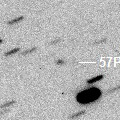
|
Now it is 16.6 mag (Aug. 28, Toshihiko Ikemura, Hirohisa Sato). It will brighten up to 15.5 mag until autumn. It stays observable for a long time.
Date(TT) R.A. (2000) Decl. Delta r Elong. m1 Best Time(A, h)
Sept. 4 16 20.83 -18 10.1 1.539 1.766 85 15.6 19:49 ( 38, 27)
Sept.11 16 35.74 -18 51.4 1.584 1.753 81 15.6 19:38 ( 38, 26)
|
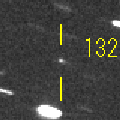
|
Now it is 16.1 mag (Aug. 28, Toshihiko Ikemura, Hirohisa Sato). It will brighten very rapidly up to 14-15 mag, and it will be observable in excellent condition in autumn.
Date(TT) R.A. (2000) Decl. Delta r Elong. m1 Best Time(A, h)
Sept. 4 0 24.39 2 50.4 0.863 1.827 154 15.9 1:33 ( 0, 58)
Sept.11 0 25.16 2 9.9 0.819 1.802 161 15.6 1:06 ( 0, 57)
|
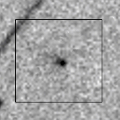
|
Now it is not observable. In the Southern Hemisphere, it will appear in the morning sky at 11 mag in late January, then it stays observable at 11 mag until June. In the Northern Hemisphere, it will appear in the morning sky in December, but it stays locating extremely low for a long time.
Date(TT) R.A. (2000) Decl. Delta r Elong. m1 Best Time(A, h)
Sept. 4 12 22.46 1 10.6 3.283 2.393 23 15.8 19:49 ( 94, -4)
Sept.11 12 34.19 -0 6.1 3.271 2.350 19 15.7 19:38 ( 93, -5)
|
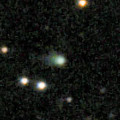
|
Now it is 15.9 mag (Aug. 29, Toshihiko Ikemura, Hirohisa Sato). It is expected to brighten up to 11 mag in 2023. In the Northern Hemisphere, it stays observable in good condition for a long time. It locates extremely low in the Southern Hemisphere.
Date(TT) R.A. (2000) Decl. Delta r Elong. m1 Best Time(A, h)
Sept. 4 16 8.14 41 51.5 6.225 6.080 77 15.7 19:49 (114, 59)
Sept.11 16 6.57 40 42.3 6.241 6.036 73 15.7 19:38 (113, 55)
|
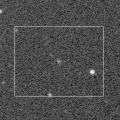
|
Now it is 16.4 mag (Aug. 20, Thomas Lehmann). It will brighten up to 12.5 mag in 2022 summer. In the Southern Hemisphere, it stays observable in excellent condition for a long time. In the Northern Hemisphere, it is not observable until August in 2022.
Date(TT) R.A. (2000) Decl. Delta r Elong. m1 Best Time(A, h)
Sept. 4 3 56.48 -63 32.2 4.328 4.654 102 15.9 4:07 (354, -9)
Sept.11 3 50.41 -65 51.6 4.275 4.606 102 15.8 4:13 (358,-11)
|
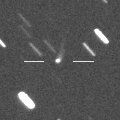
|
It was expected to brighten up to 14.5 mag from spring to summer. But actually, it is fainter than expected. Now it is 17.7 mag (July 4, Mount John Observatory, Lake Tekapo). In the Southern Hemisphere, it stays observable in excellent condition for a long time. In the Northern Hemisphere, it is not observable after this.
Date(TT) R.A. (2000) Decl. Delta r Elong. m1 Best Time(A, h)
Sept. 4 10 40.35 -53 59.7 3.347 2.997 61 15.9 4:07 (314,-42)
Sept.11 10 52.08 -53 12.8 3.440 3.031 58 16.0 4:13 (314,-39)
|
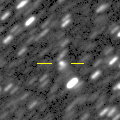
|
Now it is 15.7 mag (July 17, Toshiyuki Takahashi). It stays observable at 15-16 mag in good condition until autumn.
Date(TT) R.A. (2000) Decl. Delta r Elong. m1 Best Time(A, h)
Sept. 4 16 32.36 -11 6.8 4.814 4.862 86 15.9 19:49 ( 40, 34)
Sept.11 16 34.46 -10 34.6 4.926 4.863 80 16.0 19:38 ( 44, 33)
|

|
It brightened up to 11.6 mag in winter (Feb. 18, Thomas Lehmann). Now it is fading. It has already faded down to 15.4 mag (Aug. 20, Thomas Lehmann). In the Southern Hemisphere, it stays observable in good condition after this. In the Northern Hemisphere, it will never be observable after this.
Date(TT) R.A. (2000) Decl. Delta r Elong. m1 Best Time(A, h)
Sept. 4 5 19.37 -63 54.4 3.509 3.709 93 16.0 4:07 (345,-13)
Sept.11 5 10.13 -65 26.8 3.552 3.774 94 16.1 4:13 (350,-12)
|
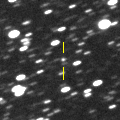
|
Now it is 16.2 mag (Aug. 28, Toshihiko Ikemura, Hirohisa Sato). It is expected to brighten up to 11 mag from spring to summer in 2022. In the Southen Hemisphere, it locates somewhat low in 2021, but it will be observable in good condition at the high light for a long time. In the Northern Hemisphere, it is observable in good condition in 2021, but it will not be observable at the high light.
Date(TT) R.A. (2000) Decl. Delta r Elong. m1 Best Time(A, h)
Sept. 4 18 54.59 25 43.7 3.228 3.749 113 16.3 19:59 ( 0, 81)
Sept.11 18 48.41 23 17.7 3.233 3.685 108 16.2 19:38 ( 14, 78)
|
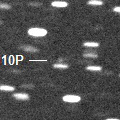
|
Now it is 16.7 mag (Aug. 29, Toshihiko Ikemura, Hirohisa Sato). It will brightens rapidly. And it will be observable at 15 mag in excellent condition in winter.
Date(TT) R.A. (2000) Decl. Delta r Elong. m1 Best Time(A, h)
Sept. 4 6 58.00 27 9.2 2.842 2.471 58 16.4 4:07 (261, 39)
Sept.11 7 10.56 26 37.1 2.764 2.467 62 16.2 4:13 (265, 43)
|
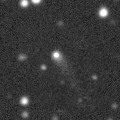
|
Now it is 16.0 mag (July 18, Ken-ichi Kadota). It stays observable at 16 mag from 2021 to 2022.
Date(TT) R.A. (2000) Decl. Delta r Elong. m1 Best Time(A, h)
Sept. 4 14 2.46 2 56.2 5.326 4.708 47 16.2 19:49 ( 81, 18)
Sept.11 14 7.27 3 8.2 5.397 4.706 42 16.3 19:38 ( 83, 15)
|
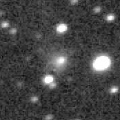
|
Now it is 16.4 mag (Aug. 30, Toshihiko Ikemura, Hirohisa Sato). It is observable at 16 mag from 2020 to 2021. It locates low in the Southern Hemisphere.
Date(TT) R.A. (2000) Decl. Delta r Elong. m1 Best Time(A, h)
Sept. 4 22 9.85 40 47.1 5.378 6.088 130 16.3 23:14 (180, 84)
Sept.11 22 2.94 39 31.7 5.371 6.098 132 16.3 22:40 (180, 85)
|
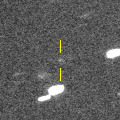
|
Now it is 17.3 mag (Aug. 29, Toshihiko Ikemura, Hirohisa Sato). It stays observable at 16 mag from autumn to winter. In the Northern Hemisphere, it stays observable in good condition. In the Southern Hemisphere, it stays extremely low until November.
Date(TT) R.A. (2000) Decl. Delta r Elong. m1 Best Time(A, h)
Sept. 4 8 23.06 25 47.1 2.456 1.802 39 16.6 4:07 (253, 21)
Sept.11 8 42.54 24 28.2 2.409 1.792 41 16.5 4:13 (256, 24)
|
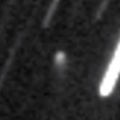
|
Now it is 17.1 mag (Aug. 2, ATLAS-HKO, Haleakala). It will brighten up to 15.5 mag in winter. In the Northern Hemisphere, it stays observable in good condition for a long time. It is not observable at all in the Southern Hemisphere.
Date(TT) R.A. (2000) Decl. Delta r Elong. m1 Best Time(A, h)
Sept. 4 16 6.32 70 21.3 3.349 3.315 79 16.5 19:49 (161, 49)
Sept.11 15 54.82 69 0.7 3.334 3.284 78 16.5 19:38 (157, 47)
|
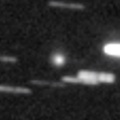
|
Now it is 16.4 mag (Aug. 30, Toshihiko Ikemura, Hirohisa Sato). It is expected to brighten up to 11 mag in 2023. In the Northern Hemisphere, it is observable in good condition in 2021. But it is observable only until November in 2022. In the Southern Hemisphere, it locates extremely low in 2021. But it will be observable in good condition at the high light.
Date(TT) R.A. (2000) Decl. Delta r Elong. m1 Best Time(A, h)
Sept. 4 17 26.28 36 14.2 6.168 6.296 92 16.5 19:49 (100, 74)
Sept.11 17 25.64 34 52.3 6.180 6.247 89 16.5 19:38 ( 96, 71)
|
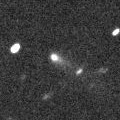
|
Now it is 16.6 mag (Aug. 18, Ken-ichi Kadota). It stays observable at 16.5 mag in good condition until October.
Date(TT) R.A. (2000) Decl. Delta r Elong. m1 Best Time(A, h)
Sept. 4 23 21.18 0 8.9 1.170 2.169 169 16.6 0:30 ( 0, 55)
Sept.11 23 15.42 0 29.0 1.167 2.171 174 16.5 23:52 ( 0, 56)
|
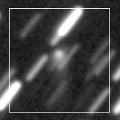
|
Now it is 16.5 mag (Aug. 29, Toshihiko Ikemura, Hirohisa Sato). It stays at 16-17 mag from 2020 to 2021. In the Northern Hemisphere, it stays observable in good condition for a long time. It locates extremely low in the Southern Hemisphere.
Date(TT) R.A. (2000) Decl. Delta r Elong. m1 Best Time(A, h)
Sept. 4 18 26.51 50 41.5 8.668 8.881 98 16.6 19:49 (170, 74)
Sept.11 18 23.87 50 19.1 8.707 8.886 96 16.6 19:38 (159, 73)
|
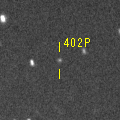
|
First return of a new periodic comet observed at 16 mag from 2003 to 2004. Now it is 16.8 mag (Apr. 11, J. Drummond). It will brighten up to 16 mag in winter, and it will be observable in excellent condition.
Date(TT) R.A. (2000) Decl. Delta r Elong. m1 Best Time(A, h)
Sept. 4 6 13.59 2 9.8 4.223 3.981 69 16.6 4:07 (295, 34)
Sept.11 6 19.17 2 0.7 4.128 3.975 74 16.6 4:13 (301, 39)
|
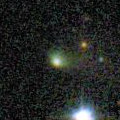
|
Now it is 15.7 mag (Aug. 29, Toshihiko Ikemura, Hirohisa Sato). It will be fading after this, and it will be fainter than 18 mag in November.
Date(TT) R.A. (2000) Decl. Delta r Elong. m1 Best Time(A, h)
Sept. 4 1 16.27 -9 26.3 1.882 2.763 144 16.6 2:25 ( 0, 46)
Sept.11 1 15.19 -10 28.3 1.874 2.792 150 16.7 1:56 ( 0, 45)
|
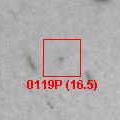
|
Now it is 18.9 mag (Aug. 3, ATLAS-HKO, Haleakala). It will brighten up to 14.5 mag in 2022 winter. In 2021, it stays observable in good condition while the comet will be brightening gradually. It is fainter than this ephemeris recently.
Date(TT) R.A. (2000) Decl. Delta r Elong. m1 Best Time(A, h)
Sept. 4 22 45.98 -17 11.7 2.199 3.197 170 16.8 23:50 ( 0, 38)
Sept.11 22 40.94 -17 47.7 2.190 3.171 164 16.7 23:18 ( 0, 37)
|
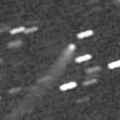
|
Now it is 16.9 mag (Aug. 29, Toshihiko Ikemura, Hirohisa Sato). Fading slowly. In the Northern Hemisphere, it stays observable in good condition for a long time. It is not observable after this in the Southern Hemisphere.
Date(TT) R.A. (2000) Decl. Delta r Elong. m1 Best Time(A, h)
Sept. 4 16 16.29 52 34.5 5.806 5.699 78 16.9 19:49 (135, 59)
Sept.11 16 14.49 51 46.4 5.878 5.732 76 16.9 19:38 (132, 56)
|

|
Now it is 17.4 mag (Aug. 29, Toshihiko Ikemura, Hirohisa Sato). In the Northern Hemisphere, it stays observable for a long time while it is getting fainter slowly. In the Southern Hemisphere, it will never be observable again.
Date(TT) R.A. (2000) Decl. Delta r Elong. m1 Best Time(A, h)
Sept. 4 13 46.12 47 54.9 7.174 6.645 54 17.0 19:49 (128, 35)
Sept.11 13 49.90 46 54.2 7.242 6.693 53 17.0 19:38 (127, 33)
|
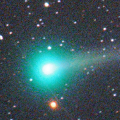
|
It brightened up to 3 mag in December in the SOHO spacecraft images (Dec. 18, Hirohisa Sato). Now it is 16.2 mag (July 22, ATLAS-MLO, Mauna Loa). It stays observable in good condition after this while the comet will be fading.
Date(TT) R.A. (2000) Decl. Delta r Elong. m1 Best Time(A, h)
Sept. 4 23 46.12 18 23.9 3.259 4.170 150 17.0 0:55 ( 0, 74)
Sept.11 23 39.80 17 41.4 3.304 4.248 156 17.1 0:21 ( 0, 73)
|
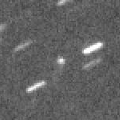
|
It will brighten up to 16 mag in 2022. In the Northern Hemisphere, it stays observable in good condition for a long time. In the Southern Hemisphere, it is not observable until 2023.
Date(TT) R.A. (2000) Decl. Delta r Elong. m1 Best Time(A, h)
Sept. 4 8 16.74 50 22.9 4.807 4.288 53 17.2 4:07 (228, 32)
Sept.11 8 25.03 51 32.7 4.692 4.259 58 17.1 4:13 (228, 37)
|
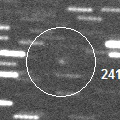
|
Now it is 17.3 mag (Aug. 28, Toshihiko Ikemura, Hirohisa Sato). In the Northern Hemisphere, it stays observable at 17 mag in good condition until winter. In the Southern Hemisphere, it stays locating extremely low for a while.
Date(TT) R.A. (2000) Decl. Delta r Elong. m1 Best Time(A, h)
Sept. 4 7 9.23 36 11.3 2.292 1.956 58 17.2 4:07 (249, 40)
Sept.11 7 26.76 35 22.3 2.251 1.971 61 17.2 4:13 (252, 43)
|
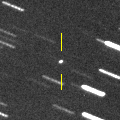
|
Now it is 17.1 mag (Aug. 18, Toshiyuki Takahashi). In the Northern Hemisphere, it stays observable in good condition after this while the comet will be fading. In the Southern Hemisphere, it stays locating extremely low for a long time.
Date(TT) R.A. (2000) Decl. Delta r Elong. m1 Best Time(A, h)
Sept. 4 5 7.65 36 44.7 2.460 2.532 82 17.3 4:07 (257, 64)
Sept.11 5 14.36 37 32.0 2.426 2.588 87 17.3 4:13 (255, 69)
|
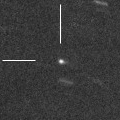
|
Now it is 17.5 mag (Aug. 12, Michael Jager). It is observable at 17 mag in good condition in autumn.
Date(TT) R.A. (2000) Decl. Delta r Elong. m1 Best Time(A, h)
Sept. 4 2 31.19 18 46.7 3.227 3.831 119 17.4 3:39 ( 0, 74)
Sept.11 2 31.76 18 36.8 3.140 3.827 126 17.3 3:12 ( 0, 74)
|

|
Now it is 17.7 mag (May 12, ATLAS-HKO, Haleakala). It brightened rapidly. It stays 17-18 mag for a long time from 2021 to 2022. In the Southern Hemisphere, it stays observable in good condition for a long time. In the Northern Hemisphere, it will be observable only in extremely low sky from autumn to winter.
Date(TT) R.A. (2000) Decl. Delta r Elong. m1 Best Time(A, h)
Sept. 4 8 56.72 -18 30.0 6.113 5.358 38 17.5 4:07 (286,-10)
Sept.11 8 59.47 -19 42.8 6.064 5.353 41 17.4 4:13 (291, -5)
|

|
Peculiar asteroid moving along a cometary orbit. It brightens up to 17 mag from September to October. In the Northern Hemisphere, it is observable in excellent condition. It is not observable in the Southern Hemisphere.
Date(TT) R.A. (2000) Decl. Delta r Elong. m1 Best Time(A, h)
Sept. 4 8 45.90 25 5.1 0.465 0.681 34 18.4 4:07 (251, 16)
Sept.11 8 39.64 43 9.6 0.448 0.810 51 17.5 4:13 (237, 32)
|
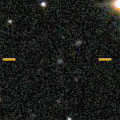
|
Now it is 18.4 mag (Aug. 30, Toshihiko Ikemura, Hirohisa Sato). It will brightens rapidly. And it is expected to be observable at 12-13 mag in good condition from December to February.
Date(TT) R.A. (2000) Decl. Delta r Elong. m1 Best Time(A, h)
Sept. 4 22 21.89 -0 31.6 0.902 1.903 170 17.9 23:26 ( 0, 54)
Sept.11 22 13.09 -1 35.4 0.855 1.843 163 17.5 22:50 ( 0, 53)
|
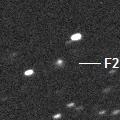
|
Now it is 17.8 mag (Aug. 4, ATLAS-HKO, Haleakala). It stays observable at 17-18 mag for a long time until 2024.
Date(TT) R.A. (2000) Decl. Delta r Elong. m1 Best Time(A, h)
Sept. 4 14 19.17 -5 22.1 9.570 9.004 53 17.5 19:49 ( 71, 16)
Sept.11 14 19.71 -5 24.8 9.655 8.996 46 17.5 19:38 ( 74, 13)
|
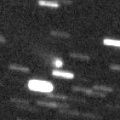
|
Now it is 16.6 mag (July 25, ATLAS-MLO, Mauna Loa). It will be fading after this, and it will be fainter than 18 mag in October.
Date(TT) R.A. (2000) Decl. Delta r Elong. m1 Best Time(A, h)
Sept. 4 15 8.90 -23 3.8 5.478 5.217 69 17.5 19:49 ( 49, 13)
Sept.11 15 8.79 -23 31.6 5.619 5.242 63 17.6 19:38 ( 52, 10)
|
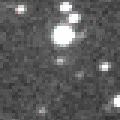
|
Now it is 17.4 mag (Aug. 30, Toshihiko Ikemura, Hirohisa Sato). It stays observable at 17-18 mag for a long time from 2021 to 2022.
Date(TT) R.A. (2000) Decl. Delta r Elong. m1 Best Time(A, h)
Sept. 4 19 4.38 -18 52.0 3.464 4.111 123 17.5 20:10 ( 0, 36)
Sept.11 19 4.93 -18 55.6 3.548 4.106 117 17.6 19:43 ( 0, 36)
|
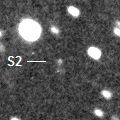
|
First return of a new periodic comet which brightened up to 17 mag in 2012. Now it is 18.3 mag (July 10, ATLAS-HKO, Haleakala). In the Southern Hemisphere, it is observable at 17.5 mag in excellent condition in summer. It locates low in the Northern Hemisphere.
Date(TT) R.A. (2000) Decl. Delta r Elong. m1 Best Time(A, h)
Sept. 4 19 34.70 -40 55.2 0.709 1.530 124 17.6 20:41 ( 0, 14)
Sept.11 19 40.39 -40 11.1 0.710 1.494 119 17.6 20:19 ( 0, 15)
|

|
It had been observed as 8-9 mag for a long time in 2020. Now it is fading. It has already faded down to 17.6 mag (July 29, J. Drummond). It will be observable in good condition after this in the Southern Hemisphere. It locates extremely low after this in the Northern Hemisphere.
Date(TT) R.A. (2000) Decl. Delta r Elong. m1 Best Time(A, h)
Sept. 4 16 10.88 -45 13.4 5.575 5.633 88 17.6 19:49 ( 26, 3)
Sept.11 16 13.48 -45 9.8 5.739 5.693 82 17.7 19:38 ( 28, 1)
|
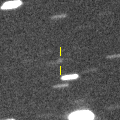
|
Now it is 17.4 mag (Aug. 28, Toshihiko Ikemura, Hirohisa Sato). It will brighten up to 15.5 mag, and will be observable in excellent condition in winter.
Date(TT) R.A. (2000) Decl. Delta r Elong. m1 Best Time(A, h)
Sept. 4 7 53.33 18 52.1 2.659 2.068 44 17.7 4:07 (263, 24)
Sept.11 8 9.61 18 16.7 2.594 2.055 47 17.6 4:13 (266, 27)
|

|
It stays 17 mag for a long time from 2021 to 2022. It is observable in excellent condition in the Northern Hemisphere, It locates somewhat low in the Southern Hemisphere.
Date(TT) R.A. (2000) Decl. Delta r Elong. m1 Best Time(A, h)
Sept. 4 5 36.97 32 22.3 5.737 5.588 76 17.7 4:07 (263, 57)
Sept.11 5 34.67 32 40.4 5.594 5.573 83 17.7 4:13 (266, 65)
|
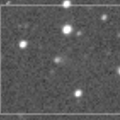
|
First return of a new periodic comet which brightened up to 17 mag in 2006. Now it is 17.4 mag (June 15, Taras Prystavski). It stays 18 mag from 2021 to 2022.
Date(TT) R.A. (2000) Decl. Delta r Elong. m1 Best Time(A, h)
Sept. 4 21 48.81 -68 32.4 2.639 3.236 117 17.7 22:54 ( 0,-13)
Sept.11 21 40.92 -67 35.7 2.666 3.223 114 17.7 22:19 ( 0,-12)
|
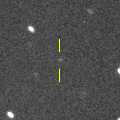
|
Now it is 18.2 mag (Aug. 28, Toshihiko Ikemura, Hirohisa Sato). It has passed the perihelion in 2020 October. At the discovery in 2005, it stayed bright for several years even after the perihelion passage. In this apparition, it may stay observable at 18 mag from 2021 to 2024.
Date(TT) R.A. (2000) Decl. Delta r Elong. m1 Best Time(A, h)
Sept. 4 23 38.21 -28 23.3 2.975 3.919 156 17.7 0:47 ( 0, 27)
Sept.11 23 34.31 -28 52.5 3.002 3.940 155 17.7 0:16 ( 0, 26)
|

|
Now it is 18.6 mag (Aug. 3, ATLAS-HKO, Haleakala). It will brighten up to 16.5-17 mag in winter. In its last apparition in 2015, it brightened up to 13 mag.
Date(TT) R.A. (2000) Decl. Delta r Elong. m1 Best Time(A, h)
Sept. 4 22 5.39 -30 56.8 1.455 2.402 154 17.8 23:10 ( 0, 24)
Sept.11 21 59.03 -31 51.2 1.449 2.360 147 17.7 22:36 ( 0, 23)
|
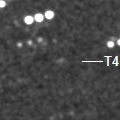
|
Now it is extremely faint as 20.5 mag (June 17, M. Jaeger, E. Prosperi, S. Prosperi). It was predicted to brighten up to 17.5 mag in 2021 summer. But actually, it is much fainter than predicted. It is not observable in the Southern Hemisphere.
Date(TT) R.A. (2000) Decl. Delta r Elong. m1 Best Time(A, h)
Sept. 4 13 58.69 49 25.4 2.681 2.302 57 17.8 19:49 (129, 37)
Sept.11 14 11.79 45 22.8 2.741 2.327 55 17.9 19:38 (124, 36)
|
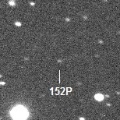
|
Now it is 17.7 mag (July 13, ATLAS-MLO, Mauna Loa). It will brighten up to 16 mag in 2022. In 2021, it stays observable at 18 mag until September.
Date(TT) R.A. (2000) Decl. Delta r Elong. m1 Best Time(A, h)
Sept. 4 14 17.12 -7 35.2 3.672 3.175 53 17.8 19:49 ( 70, 14)
Sept.11 14 25.53 -8 35.1 3.736 3.167 48 17.8 19:38 ( 70, 12)
|

|
Now it is 17.6 mag (Aug. 30, Toshihiko Ikemura, Hirohisa Sato). It will be fading slowly.
Date(TT) R.A. (2000) Decl. Delta r Elong. m1 Best Time(A, h)
Sept. 4 16 53.76 -10 48.5 7.917 8.015 91 17.8 19:49 ( 35, 37)
Sept.11 16 52.75 -10 44.1 8.066 8.041 85 17.9 19:38 ( 39, 35)
|
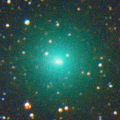
|
It brightened up to 8.2 mag in 2020 autumn (Oct. 13, 2020, Chris Wyatt). Now it is 18.9 mag (July 15, Palomar Mountain--ZTF). It is observable at 18 mag in 2021.
Date(TT) R.A. (2000) Decl. Delta r Elong. m1 Best Time(A, h)
Sept. 4 5 8.57 23 10.8 3.185 3.225 83 17.9 4:07 (284, 59)
Sept.11 5 12.16 23 20.1 3.118 3.262 89 17.9 4:13 (292, 65)
|
|
![]()
 104P/Kowal 2
104P/Kowal 2 C/2020 F2 ( ATLAS )
C/2020 F2 ( ATLAS ) C/2017 Y2 ( PanSTARRS )
C/2017 Y2 ( PanSTARRS ) 395P/2020 H1 ( Catalina-NEAT )
395P/2020 H1 ( Catalina-NEAT ) 424P/2021 L5 ( La Sagra )
424P/2021 L5 ( La Sagra ) C/2017 T2 ( PanSTARRS )
C/2017 T2 ( PanSTARRS ) 70P/Kojima
70P/Kojima C/2020 U4 ( PanSTARRS )
C/2020 U4 ( PanSTARRS ) 422P/2021 L1 ( Christensen )
422P/2021 L1 ( Christensen ) 378P/2019 E2 ( McNaught )
378P/2019 E2 ( McNaught ) 230P/LINEAR
230P/LINEAR C/2020 T4 ( PanSTARRS )
C/2020 T4 ( PanSTARRS ) 152P/Helin-Lawrence
152P/Helin-Lawrence C/2017 U7 ( PanSTARRS )
C/2017 U7 ( PanSTARRS ) 88P/Howell
88P/Howell![]()








































































